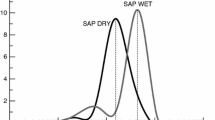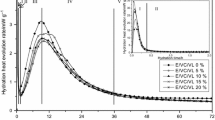Abstract
Ordinary Portland cement mixed with various amounts of absorbent polymer in the form of sodium acrylate ((–CH–)nCOONa) have been studied. As the content of absorbent polymer increased, heat evolution of samples decreased up to 1.15 wt % of absorbent polymer addition and conversely increased over 1.75 wt %. Flexural strength of cement paste with absorbent polymer was improved more than 20%. As the content of absorbent polymer increased, the porosity values decreased and mean pore diameter shifted to small pore diameter region. Flexural strength of ordinary Portland cement paste had a linear correlation with non-evaporable water content but, that of cement paste with absorbent polymer deviated from a linear correlation with non-evaporable water content. The chemical difference between cement pastes with and without absorbent polymer was found by the inductively coupled plasma-atomic emission spectroscopy and the infrared spectroscopy. For the infrared spectra of absorbent polymer, bands at 1416 and 1560 cm− 1 were assigned to C–O single bond and C=O double bond respectively, namely, unidentate complex. As the curing time increased, the absorption bands near 1416 cm− 1 shifted to longer wave number and the absorption bands near 1560 cm− 1 to shorter wave number and finally bidentate complex was formed. Absorbent polymer released sodium ions to pore solution under the basic condition of pH 12.5–13.5 and became polyacrylic acid. Then some of these polyacrylic acid were crosslinked with others by calcium ions leached from cement grains. Calcium ion was regarded as a central charge connecting the negative parts in carbon-oxygen polarization of absorbent polymer' functional groups.
Similar content being viewed by others
eferences
V. S. Ramachandran, “Concrete Admixtures Handbooks —Properties, Science and Technology” (Noyes Publications, New Jersey, 1984).
J. D. Birchall, Phil. Trans. R. Soc. Lond. 2 (1983) 31.
J. Francis young, Mater. Res. Soc. Symp. Proc. 179 (1991) 101.
W. Sinclair and G. W. Groves, J. Mater. Sci. 20 (1985) 2846.
L. Ben-dor and C. Heitner-wirguim, Cem. Con. Res 15(4) (1986) 681.
J. Jambor, ibid. 20 (1990) 948.
C. Safish and A. Su, Polym. Concr. Int. Cong. 7 (1992) 135.
L. Brannon-peppas and R. S. Harland, “Absorbent Polymer Technology” (Elsevier, 1990).
C. Y. Rha, Thesis, Yonsei University, Korea, 1993.
S. Jackson and D. L. Cocke, J. Environ. Sci. Health A24(6) (1989) 589.
L. J. Bellamy, “The Infrared Spectra of Complex Molecules” (Methuen, London, 1954).
K. Nakamoto, “Infrared Spectra of Inorganic and Coordination Compounds” (John Wiley, New York, 1963).
H. F.W. T ATLOR “Cement Chemistry” (Academic Press, London, 1990).
Author information
Authors and Affiliations
Rights and permissions
About this article
Cite this article
Rha, C.Y., Seong, J.W., Kim, C.E. et al. Properties and interaction of cement with polymer in the hardened cement pastes added absorbent polymer. Journal of Materials Science 34, 4653–4659 (1999). https://doi.org/10.1023/A:1004689711139
Issue Date:
DOI: https://doi.org/10.1023/A:1004689711139




